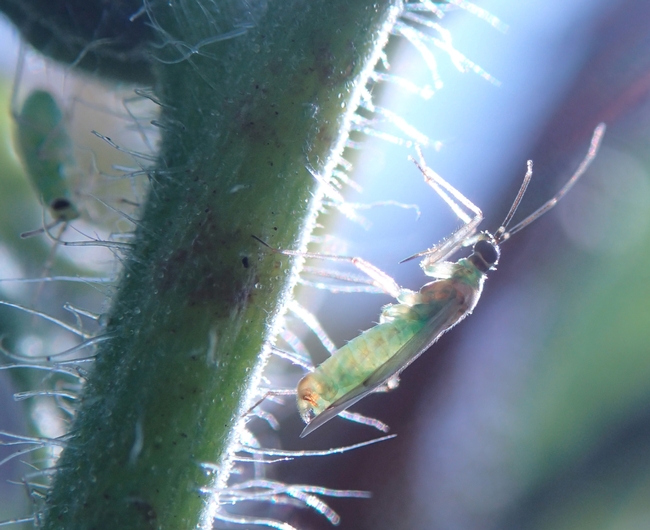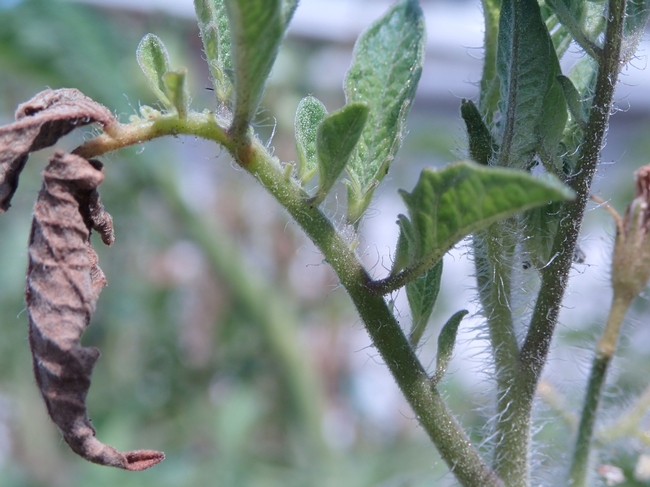Adult tomato bug (Cyrtopeltis modesta) on backyard tomato plant. See its slender, greenish body and needle-like mouthparts. (Photo by Jessie Altstatt, Goleta)
A homeowner in Goleta recently reported severe infestation and damage of tomatoes by the tomato bug, Cyrtopeltis modesta (Distant) in their home garden. It also appears that they have become more frequent in recent years. This article provides an overview of the pest and some management options.
Tomato bug also known as tomato suck bug belongs to the family Miridae in the order Hemiptera. Lygus bug and other plant bugs also belong to the same family. There seems to be some confusion in the description of C. modesta (Engytatus modestus) and without a good key, identification of related species such as C. tenuis, C. geniculata, and Dicyphus spp. can be complicated.
Origin and distribution: Origin of C. modesta was not clear in literature, but Carvalho and Usinger (1960) referred to it as an American species while reporting a new species of Cyrtopeltis from Hawaii. Tomato bug is reported from Europe, South America, and North America and its related species from other parts of the world.
Biology and identification:
Adults are 7-8 mm or 0.25” long. Body is slender, pale and has a green or red tinge. Pronotum (shield like plate on the thorax) is narrow. Eyes are small. Wings are membranous, pale green or translucent. Nymphs look similar to adults, but without wings or with developing wing pads. There are four to five nymphal instars. Eggs are laid inside the petiole or the terminal shoots. Nymphs and adults actively feed.
Adult (above) and nymphal stages (below) of tomato bug. Nymphs can be seen with no wings or developing wing pads. (Photos by Jessie Altstatt, Goleta)
Damage
Nymphs and adults actively feed by inserting their piercing and sucking mouthparts in plant tissues and sucking the juices. Yellowish red rings develop around the stem as a result of feeding. These areas are corky and break easily leading to the dropping off of flowers or developing fruit. Tomato bugs are common in Central Valley and Southern California both in organic and conventional tomatoes. However, they are usually not a problem in large farms where pesticides are applied to manage major tomato pests. They can be a problem in home gardens and small farms where pesticide treatments are less common (Tom Turini, personal communication).
Damaged leaves and flower from tomato bug feeding. (Photo by Jessie Altstatt, Goleta)
Management
There is no information available on natural enemies, pesticide treatments, or other management options specific to tomato bugs. Pesticides that are usually effective against lygus bugs (http://www.ipm.ucdavis.edu/PMG/r783301611.html) or stink bugs (http://www.ipm.ucdavis.edu/PMG/r783300211.html) in tomatoes can be effective against tomato bugs. Based on my research on other hemipterans, botanical insecticide/insect growth regulator – azadirachtin (especially against nymphal stages) and insect pathogenic fungi – Beauveria bassiana, Metarhizium brunneum (M. anisopliae), or Isaria fumosorosea (Paecilymyces fumosoroseus) can also be effective against tomato bugs. These could be good alternatives to chemical pesticides for home gardens.
http://ucanr.edu/articlefeedback
References
Carvalho, J.C.M. and R. L. Usinger. 1960.New Species of Cyrtopeltis from the Hawaiian Islands with a Revised Key (Hemiptera: Miridae). Proc. Hawaiian Entomol. Soc. 17: 249-254.
Goula, M. and O. Alomar. 1994. Míridos (Heteroptera Miridae) de interés en el control integrado de plagas en el tomate. Guía para su identificación. Bol. San. Veg. Plagas 20: 131-143.
Letourneau, D. K. and B. Goldstein. 2001. Pest damage and arthropod community structure in organic vs. conventional tomato production in California. J. Appl. Ecol. 38: 557-570.
Swezey, O. H. 1925. Notes and Exhibitions (Sept. 4, 1924). Proc. Haw. Ent. Soc, 6:18.
UC IPM http://www.ipm.ucdavis.edu/PMG/r783301811.html
University of Arizona http://ag.arizona.edu/ceac/sites/ag.arizona.edu.ceac/files/pls217nbCH4_3.pdf.
Taxonomic references:
http://zipcodezoo.com/Animals/C/Cyrtopeltis_modesta/
http://research.amnh.org/pbi/catalog/names.php?name_kwd=cyrtopeltis





